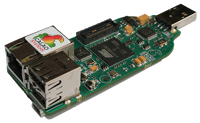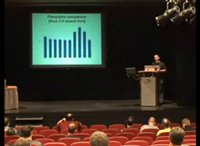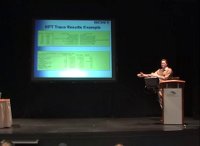Interesting features in Linux 2.6.30 for embedded system developers
Linux 2.6.30 has been released almost 1 month ago and it’s high time to write a little about it. Like every new kernel release, it contains interesting features for embedded system developers.
The first feature that stands out is support for fastboot. Today, most devices are initialized in a sequential way. As scanning and probing the hardware often requires waiting for the devices to be ready, a significant amount of cpu time is wasted in delay loops. The fastboot infrastructure allows to run device initialization routines in parallel, keeping the cpu fully busy and thus reducing boot time in a significant way. Fasboot can be enabled by passing the fastboot parameter in the kernel command line. However, unless your embedded system uses PC hardware, don’t be surprised if you don’t get any boot time reduction yet. If you look at the code, you will see that the async_schedule function is only used by 4 drivers so far, mainly for disk drives. You can see that board support code and most drivers still need to be converted to this new infrastructure. Let’s hope this will progress in future kernel releases, bringing significant boot time savings to everyone.
 Linux 2.6.30 also features the inclusion of Tomoyo Linux, a lightweight Mandatory Access Control system developed by NTT. According to presentations I saw quite a long time ago, Tomoyo can be used as an alternative to SELinux, and it just consumes a very reasonable amount of RAM and storage space. It should interest people making embedded devices which are always connected to the network, and need strong security.
Linux 2.6.30 also features the inclusion of Tomoyo Linux, a lightweight Mandatory Access Control system developed by NTT. According to presentations I saw quite a long time ago, Tomoyo can be used as an alternative to SELinux, and it just consumes a very reasonable amount of RAM and storage space. It should interest people making embedded devices which are always connected to the network, and need strong security.
Another nice feature is support for kernel images compressed with bzip2 and lzma, and not just with zlib as it’s been the case of ages. The bzip2 and lzma compressors allow to reduce the size of a compressed kernel in a significant way. This should appeal to everyone interested in saving a few hundreds of kilobytes of storage space. Just beware that decompressing these formats requires more CPU resources, so there may be a price to pay in terms of boot time if you have a slow cpu, like in many embedded systems. On the other hand, if you have a fast cpu and rather slow I/O, like in a PC, you may also see a reduction in boot time. In this case, you would mainly save I/O time copying a smaller kernel to RAM, and with a fast cpu, the extra decompression cost wouldn’t be too high.
However, if you take a closer look at this new feature, you will find that it is only supported on x86 and blackfin. Alain Knaff, the author of the original patches, did summit a patch for the arm architecture, but it didn’t make it this time. Upon my request, Alain posted an update to this arm patch. Unfortunately, decompressing the kernel no longer works after applying this patch. There seems to be something wrong with the decompression code… Stay tuned on the LKML to follow up this issue. Note that the blackfin maintainers took another approach, apparently. They didn’t include any decompression code on this architecture. Instead, they relied on the bootloader to take care of decompression. While this is simpler, at least from the kernel code point of view, this is not a satisfactory solution. It would be best if the arm kernel bootstrap code took care of this task, which would then work with any board and any bootloader.
Another interesting feature is the inclusion of the Microblaze architecture, a soft core cpu on Xilinx FPGAs. This MMU-less core has been supported for quite a long time by uClinux, and it’s good news that it is now supported in the mainline kernel. This guarantees that this cpu will indeed be maintained for a long time, and could thus be a good choice in your designs.
Other noteworthy features are support for threaded interrupt handlers (which shows that work to merge the real-time preempt patches is progressing), ftrace support in 32 and 64 bit powerpc, new tracers, and of course, several new embedded boards and many new device drivers.
As usual, full details can be found on the Linux Kernel Newbies website.

 150MHz RDC CPU, Intel 486SX compatible
150MHz RDC CPU, Intel 486SX compatible At the time of this writing, most documentation that you can find on the web about the Beagle board will tell you that you need to take special preparation steps if you wish to boot your board on an MMC/SD card:
At the time of this writing, most documentation that you can find on the web about the Beagle board will tell you that you need to take special preparation steps if you wish to boot your board on an MMC/SD card:


 2 USB 2.0 host ports, allowing to connect any type of device. In particular, we are thinking about USB mass storage and webcam devices.
2 USB 2.0 host ports, allowing to connect any type of device. In particular, we are thinking about USB mass storage and webcam devices.



